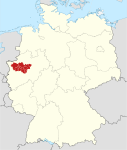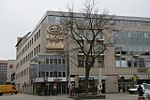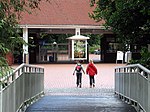Dortmund-Hörde station
Railway stations in DortmundRailway stations in Germany opened in 1855

Dortmund-Hörde station is a passenger station in the Dortmund district of Horde in the German state of North Rhine-Westphalia. It is classified by Deutsche Bahn as a category 4 station.It is owned by Deutsche Bahn and is located on the Dortmund–Soest railway. The station had an important function as a freight yard, especially for traffic to and from coal mines and steel works. The old station was destroyed during the Second World War and replaced by a purpose-built station in 1955. The station was rebuilt between 2010 and 2013.
Excerpt from the Wikipedia article Dortmund-Hörde station (License: CC BY-SA 3.0, Authors, Images).Dortmund-Hörde station
Bezirksverwaltungsstelle, Dortmund Hörde (Hörde)
Geographical coordinates (GPS) Address Nearby Places Show on map
Geographical coordinates (GPS)
| Latitude | Longitude |
|---|---|
| N 51.487777777778 ° | E 7.4997222222222 ° |
Address
Dortmund-Hörde
Bezirksverwaltungsstelle
44263 Dortmund, Hörde (Hörde)
North Rhine-Westphalia, Germany
Open on Google Maps









